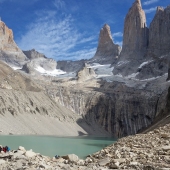
New Machu Picchu Airport Scheduled to Open in October 2024
After years of wrangling over property rights and other legal mumbo-jumbo, the construction of an airport in the farmlands surrounding Chinchero is well underway. But still tainted by disagreements for approving design decisions, the struggle to move forward is frought with interruptions. The process for obtaining consistency in supply chains and approval for permits is complicated. As of September 1, 2022, it's expected that the airport will not be operational by the planned July 2025 date. They're throwing out the original grand opening date for now. I won't go into the details about the cause of the delays.
On May 30, 2024, it was announced that the opening of the new Machu Picchu airport will be delayed, again, until September 1, 2026. Although if all the supply chain ducks get lined up and stay lined up, opening date could be accelerated to April 29, 2026. Keep your feathers crossed for good luck!
The civil works will be conducted by an alliance of companies including Hyundai Engineering and Construction CO, LTD from Korea, Sinohydro Corporation Limited from China, ICA Construction SA de CV from Mexico, and HV Contractors from Peru. Supervising the work is AICC Consortium comprised of several companies.
Before Covid, the small airport in Cusco struggled to keep up with demand for flights, most of which came from Lima, Peru, where nearly all international visitors land. Outdated infrastructure, combined with no where to expand at the Cusco airport were factors in limiting the arrival of international flights from countries in South America. Although in recent years several airlines managed to get limited flights from Bogota, Columbia, La Paz, Boivia and Santiago, Chile on the schedule. (keep in mind that after the pandemic, flight schedules have changed)
The new airport is likely to affect many things in the region. Some of which will be determined after it opens. Most importantly is, which way will the money flow? The comments below are my personal opinions based on my experience and discussions with my friends in Cusco. Other people may have different opinions.
Why is the Location of a New Airport to Machu Picchu Important?
The location of the airport is important in determining which direction the flow of tourist money will go. The village of Chinchero is located about 30 or 40 minutes drive on a congested 2-lane road from Cusco. The village is on the way to the Sacred Valley and Ollantaytambo, which happens to be where the main train station to Machu Picchu is located. Although the Poroy train station is literally 15 minutes from Chinchero, there is limited train service and that section of railroad tracks is typically closed from January 1-April 30 every year during the rainy season when tracks are most likely to be affected by the oocasional mudslide. The big question is, how will the location of the new Chinchero airport affect the flow of visitors whose main objective is to see Machu Picchu? Will they make the effort to backtrack just to see Cusco?
How Does Altitude of Chinchero Airport Affect the Movement of Travelers?
Because of the high altitude, 12,340 ft/3750 m, at Chinchero, which is more than 1000 ft higher than Cusco, it's not likely that many visitors, most of whom are coming from sea level, will choose to arrive and hang out near the village. Frankly, there is no infrastructure in place to accommodate visitors. However, I"m betting you'll see restaurants and hotels pop up nearby. But it's a risky investment in my opinion. Most travelers will opt to arrive and head out of town immediately to avoid the potential affects of altitude sickness. The new airport will be that much closer to the Sacred Valley which is why I predict that the Sacred Valley will explode with new hotels and restaurants. Infrastructure baby! That's where the action is.
What will Happen to the City of Cusco?
I expect to see a drop in overall traffic to Cusco, but by no means an abandonment. Hotels may have to lower their rates to entice visitors away from the Sacred Valley. For people who are planning to spend a week or more in Peru, Cusco is a must-see destination. It's exotic and has enough infrastructure to handle the needs of travelers seeking to explore and dine close to their hotel. But for cruise passengers and other people booking short vacations to Machu Picchu, it will now be possible to fly in to Chinchero, travel to the Machu Picchu ruins, then back to the airport to fly out, and not even see Cusco at all.
What will happen to the old Alejandro Valasco Astete Cusco Airport?
Discussions are underway to determine what to do with the huge parcel of land in Cusco. One proposal is to create a giant ecological park including a modern convention center, an amphitheater and a regional theater. The debate over the use of the current airport grounds after the completion of the construction of the Chinchero International Airport is still in progress.
More about the New Airport at Chinchero
Chinchero airport is expected to receive more than 6 million visitors a year. That's a 60% increase in visitors from 2018/19! Currently Alejandro Velasco Astete International Airport in Cusco receives an average of 30 flights per day (pre-covid) and estimated 3.5 million visitors in a year. (pre-covid) The new airport will be 3.5 times wider than the old airport and the airstrip extended by 17%.
How will the quaint village of Chinchero be affected by the new airport?
I would kiss the quaint village goodby. If you build an international airport in any village in the world, what do you think is going to happen to that village? The village of Chinchero is home to Peruvian qechua farmers and weavers and their traditional culture doesn't stand a chance against the massive modern industiral complex. The new airport will change everything forever. Currently there is very little infrastructure to accommodate tourism in Chinchero and that's why it's so charming. Qechua women, who are renowned for their weaving skills, have formed small co-ops where visitors could drop in and hangout to watch the women demonstrate how they process wool from llamas and sheep to create colorful textiles, for which they have become famous. New restaurants and toilets for tourists will nudge out the farmers or turn them into living statues on display and monetized for profits, very little of which will make its way to the weavers.
What's the Biggest Issue for Handling Such a Huge Increase in Visitors to Machu Picchu?
In my opinion, the roads are the stumbling block. The road system in and out of Cusco to Chinchero is horrendous. The road through the Sacred Valley is 2-lane traffic and subject to congestion from slow vehicles, local pedestrians and curves. The only good thing I can say is that the roads are paved. There's no public transportation in the region and the majority of travelers move around in private taxis and tour operator buses and vans. Using roads. I can't picture all the additional vehicles needed to move an extra 2.5 million people on their way to Machu Picchu! If you're thinking why not take a train! Nope. The Poroy station is a small outpost of departures that is only open May 1 - December 31 because of the risk of mudslides in the rainy season.
Can travelers get to Machu Picchu in fewer days after the new airport is open?
Instead of being 4-5 hours travel time each way from Cusco, the new airport will knock off 30 minutes of driving to the train station in Ollantaytambo. There is a small train station in Poroy with limited service from May-Dec. This reduction in driving time is not a substantial impact on the total time it takes to get to Machu Picchu. It's not likely that visitors will be able to trim down the current 3-day minimum needed to visit Machu Picchu, even with the new airport. The impact of the new airport will most likely affect the comfort of people on short vacations. Skipping the congestion around Cusco is a bonus for short trips to Machu Picchu. The big advantage for having a new airport in Chinchero is not to reduce the travel time to Machu Picchu. It's more about improving access to Machu Picchu and increasing the number of visitors to the region. A few months ago a plan was hatched (again) to build the first road ever to Machu Picchu. Finally, the rumble of bulldozers and dynamite has begun. But guess what? The road is not actually going all the way to Machu Picchu.
Is there any good news about building a new international airport in Chinchero?
To be fair, the benefits of having 5000 new jobs is not to be ignored. The local economy is expected to thrive from the positive impact that gainful employment brings to a community. Having a new modern udpated airport means that international flights can bypass Lima and land directly in Cusco. Lima might not be happy about this, but that's another story. Imagine flying directly to Cusco from Bogota, Rio de Janeiro, Buenos Aires, Santiago, Quito, Panama and other cities in America? You could get in an out of Machu Picchu in a minimum of maybe 2 days instead of three.













